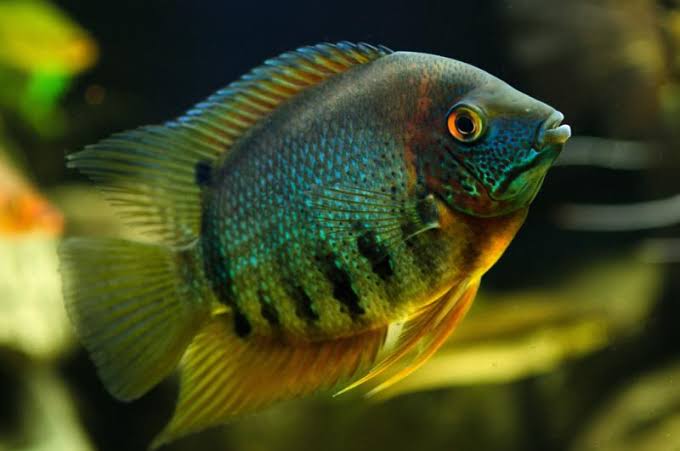Overview
| Synonyms | Chromys appendiculata, C. fasciata, Cichlasoma severum perpunctatum, Heros appendiculatus, Uarus centrarchoides |
| Distribution | Brazil and Peru. |
| Maximum Size | 20cm (7.9") |
| Temperature | 23-29°C |
| Water Parameters | Captive-bred fish will acclimatise to a wide range of conditions. Wild-caught fish should be provided with soft, acidic water. |
| Compatibility | Community with no small fish |
| Lighting | No special requirements |
| Sexual Dimorphism | Mature males usually have more pointed dorsal and anal fins. |
| Feeding |
Flake, granules, cichlid pellets and frozen foods |
Care
The Green Severum is a peaceful species, suitable for communities of non-aggressive medium-large sized fish. In the wild, the gentle Green Severum can be found in slow-moving waters packed with heavy with vegetation. Therefore the aquarium should include plenty of robust plant species along with numerous rocky caves and bogwood pieces. Green Severums can be kept in groups or pairs, but should a pair choose to spawn in a community setting, they will become much more aggressive towards the other fish. Ideally the tank will be at least 4ft long with lots of visual barriers for the other fish to escape the Green Severums attentions. Male fish can be sexed by the presence of cheek markings lacking in the smaller females. If the male seems to overly harass the female, many aquarists find that adding a couple more females will help to spread the brunt of the aggression. After a time, these fish learn to "˜recognise"™ their owner and often come to the glass to greet them or wait for food. A gold variety of this species is also available.
Feeding
Slow-sinking cichlid pellets, flake, lettuce, spinach, frozen foods such as mosquito larvae, brineshrimp, Mysis shrimp, Krill etc. Will avidly consume soft-leaved plants.
Breeding
A breeding aquarium should be set up with soft, acidic water and the pair acclimatised across. The temperature should be carefully raised to 30 °C. Some flat pieces of slate should be provided, which the fish will clean prior to laying the eggs on them. The female usually deposits between 200 and 1000 eggs onto the rocks, and these are then vigorously defended by both parents. The eggs should hatch after 48-72 hours, and once free-swimming the parents will be seen herding them to different areas or pits dug in the substrate. The young can be offered finely powdered flake foods and microworms. It is not unusual for parental care to last up to 6 weeks

